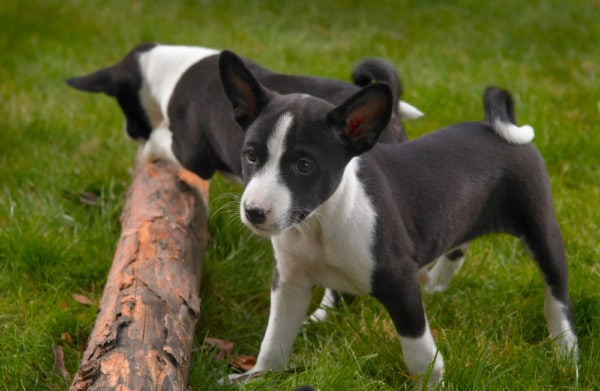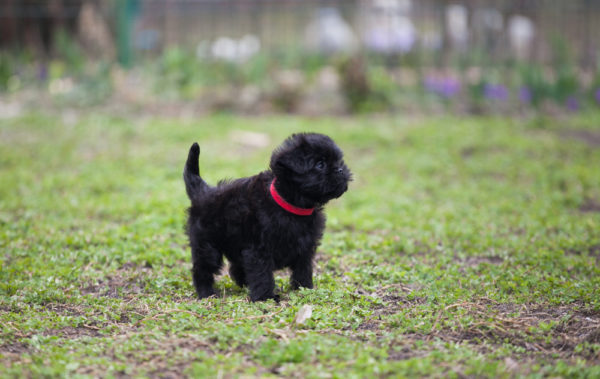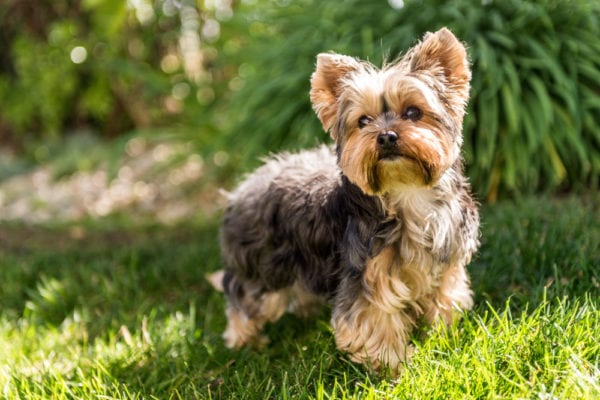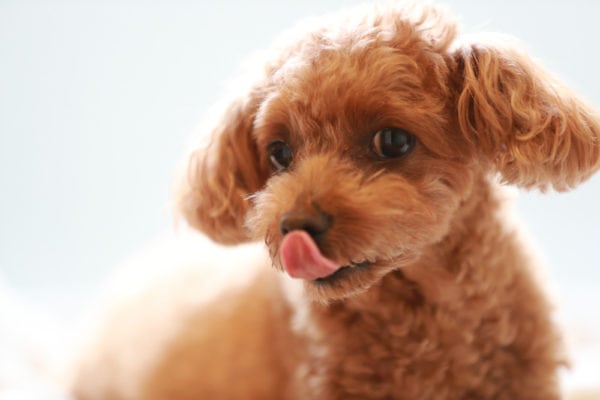Small Hypoallergenic Dogs That Are Easy to Train

Thinking of getting a pooch for your little ones? Is the thought of shedding bothering you a lot? The good news is, not every dog breed will shed. And even if they do a bit, not all of them can trigger allergies. What are we talking about? The best hypoallergenic small dogs for kids, of course!
Contents
- Does My Kid Need a Dog?
- The Best Hypoallergenic Small Dogs For Kids
- 1. Poodles: No Shedding And Very Energetic
- 2. Basenji: The Small Hairless Hound
- 3. Affenpinscher: The Fearless Little Lapdog
- 4. Lhasa Apso: The Ancient Guard Dog
- 5. Terriers: The Ones With a Saint's Patience
- Keeping a Dog: Allergies and More
- Signs of a Dog Allergy:
- What Causes an Allergy?
- What are Hypoallergenic Dogs?
- FAQs:
- The Best Small Hypoallergenic Dogs For You
Does My Kid Need a Dog?
This is perhaps the most important question of all. Is your child ready for a dog? Would your pooch thrive in your home environment? Here are some signs that may be able to help you decide.
- YES, if your child behaves well with dogs. You may not have a dog yet, but if your child behaves well with dogs around, then it may be time to get a pet. Kids need to know to wait for the dog to approach them instead of the other way around. There should not be any fear or hesitation in them for the dog, as well. Of course, if the only concern is shedding or allergies, then you need to choose a pet from a whole variety of best small hypoallergenic dogs.
- NO, if there is no time left in the day for a dog. In case your kids are shuttling between school, classes, tuition, and more; a pet may not work. If none of you have time to get your meals and enough sleep in – then a dog may not be a good idea. Dogs and pets, in general, need love, time, and attention. If you do not have the time, do not get the dog. If you can make the time, but fear the grooming, then it's simple. Get one of the best small hypoallergenic dogs that require little to no maintenance.
- YES, if your kids help around with chores and are responsible. Kids are amazing in their capacity to learn, retain, and apply. So if your kids are pulling their weight around the house, they may just be ready to take on more. If they are being responsible for themselves and showing care for others, a dog will help them develop into empathetic human beings. It is said that pets really make us better than who we are. So if the children are being conscientious, a pooch it is.
- NO, if your kids are distracted and a bit hyper. There are families where the kids are hyper, low on attention, and fidgety to the extreme. Frankly, most kids are like that. And in case you have a lot of little ones around, it may be tough to keep a pet. Even if the kids are not little but basically race up and down the house all day long, a dog may get in the way. Or worse, turn irritable, moody, and aggressive.
- YES, if your kids have researched breeds. If your children are dedicated enough to have researched doggy breeds, you may want to rethink your no. This indicates that not only are your kids ready to have a dog, they are also ready to make it a smooth process. Your no-shedding rule may have been in the way but kids are innovative. They must have compiled a whole list of the best small hypoallergenic dogs for you to consider, and comply with!
- NO, if there is another member coming to the family soon. Finally, if you are expecting a little one sometime soon, it's the worst time to get a dog. Soon-to-be mommies don't need the added stress of caring for and cleaning up after a new pet. And the kid's attention will soon be on their littlest sibling rather than their pet pooch. Makes for bad doggy behavior and overall chaos at home.
The Best Hypoallergenic Small Dogs For Kids
In case you finally decided to go ahead with adopting a pup, well, congratulations! You just added a great member to your family. And it's proven: people with pets live longer and healthier lives. So, kudos to that. On that note, here go the ten best hypoallergenic small dogs for kids, the kind that requires little to no maintenance, and can aid in keeping any allergic flare-ups to the minimum.
1. Poodles: No Shedding And Very Energetic
Intelligent, easy to train, and eager for just about anything, poodles are an active and hypoallergenic dog breed. They love being energetic so prefer being with children. That said; these are not low-intelligence dogs. Poodles were originally bred and trained as water retrievers so they thrive on new tricks, challenges, and games. In intelligence, they are ranked second, just a step behind the very smart Border Collie.
Poodles do shed, but the shed hair tends to get entangled in the coat and will need to be brushed out. The grooming depends on the length of the poodle's hair, but if you get the hair clipped short, brushing is needed just once in 6-8 weeks or so.
Poodles come in three sizes: standard, toy, and miniature. Out of the three, standard poodles have the most patience for a small child but miniature poodles and the toy poodle work best with older kids. Fear can make them bite though if the children aren't being supervised.
Standard poodles have a life expectancy of 10-12 years whereas this goes to 10-14 years for miniature and toy poodles.
Overall, poodles shed less and release minimal dander in the air, so are considered a very effective hypoallergenic breed.
Pros:
- The curly hair of the poodle does not shed
- They are good with children but with supervision
- They come in many colors and sizes
- Grooming is minimal for clipped coats
Cons:
- They can be aggressive around smaller children
- Poodles can be afflicted with genetic disorders
- These adorable pooches have a medium life expectancy
- They do not like to be left alone or out
- Can get noisy with barking at times
2. Basenji: The Small Hairless Hound

The Basenji becomes a perfect fit for those who yearn for a hound, minus the size and hair issues. The breed was imported to America and England after many failed attempts. It belonged to Africa and it was the English settlers that brought it down.
The Basenji is a short dog with beautiful markings, sometimes in brindle or tri-colors, too. The breed has been said to be very intelligent, but in international rankings, it stands at #78 out of a total of 79 breeds. A marked contrast to the poodle. That said; the Basenji is an alert, energetic, and inquisitive pet that thrives on activity and exercise.
They are good with children but older children are better suited to the Basenji temperament. Basenjis are great with family but rather aloof with strangers and take plenty of time to thaw when meeting someone new. They are independent and not the kind of dog you could train to do tricks.
Their inquisitive and courageous nature makes them a good pet for families that spend a lot of time in the outdoors.
The Basenji doesn't bark but has a yodel-like sound, because of a peculiarly-shaped larynx and is a rather quiet dog at home, as well. It just needs an occasional brush every now and then and is also odorless.
Pros:
- An alert and active dog
- Barely barks and is very quiet
- Good with children
- Is odorless and doesn't shed
- Is a fierce protector, as well
- Biweekly grooming will work for the Basenji
Cons:
- Can be impatient with smaller children
- Difficult to train as it prefers to do its own thing
- Is very independent
- Prone to certain diseases of kidney and eyes
3. Affenpinscher: The Fearless Little Lapdog

If you want a dog that is courageous to the extreme and remains unencumbered by its size – then you need an Affenpinscher. They are known as the mustached devil in France and the monkey-faced terrier in Germany – more so because of their fearless and mischievous nature.
They are loyal and affectionate and love spending time with their family. Affenpinschers are territorial about their food and toys. This is not a pet we'd be recommending in homes with small, grabby children because these little dogs can turn aggressive and moody then.
It needs varied training as it becomes easily bored but also responds to a firmer hand more than a lax one. The coat is rather rough and wiry and as long as it is clipped to a reasonable length and brushed frequently, poses no problems to allergy sufferers.
These dogs were originally bred to kill pests and rodents in stables. But their appearance soon found favor with the lady of the house – and so it became a homebound pet.
The Affenpinscher thrives in an apartment due to its small size. It also barks only when necessary. That said; it cares two hoots about its size when it comes to aggression and faces off like a much bigger dog would do.
Pros:
- It's an active breed and loves to play
- Despite the bushy coat, it sheds minimally
- Famous for their great sense of humor
- They are fearless and brave despite their small size
- Bark only when necessary so aren't noisy dogs
Cons:
- They are territorial about their food and toys so can be impatient with small children
- Will need weekly grooming
- Can be aggressive if not exercised
- Can have health issues with hind legs, eyes, and heart
- Need to be patiently trained
4. Lhasa Apso: The Ancient Guard Dog

A Lhasa Apso comes from a long line of sociable dogs who are comically friendly with members of the house but often stay regally aloof with strangers. They are very cute and snuggly, and despite their size are excellent household protectors.
The Lhasa Apso is originally from Tibet and may look small and delicate but is a hardy dog that can grow to be one happy pet. It does need attention and plenty of exercise and also does not tire easily.
The purpose of this dog was to serve as guard and sentinels high up in the Tibetan monasteries and temples. Lhasa means Tibet's sacred city while Apso means long-haired dog. So the Lhasa Apso means long-haired sentinel of Lhasa and a representative of Tibet's bearded snow lion – a mythological protector of the city.
It does not shed much but needs weekly grooming to keep its hair in order. You can always have the hair clipped short but a weekly brush is a must to keep this little cutie's coat in the best of health.
Pros:
- Fiercely protective and aloof with strangers
- Shorter haircuts lead to little or no shedding
- Calm but fun-loving
- Bred as a protector
- Needs only weekly grooming
- Are mostly healthy and sturdy dogs
- Barks when necessary
Cons:
- Is better with slightly older kids
- Needs regular attention to keep it in good spirits
- It does not tire easily so needs plenty of play
5. Terriers: The Ones With a Saint's Patience

From the Yorkshire terrier or Yorkie and Cairn terrier to the Wire Fox Terrier or even the Scottish terrier, Bedlington terrier, or Welsh terrier – these small but hairy dogs shed very little, though they need once-a-week grooming.
Terriers are mostly small to medium-sized dogs, such as the Tibetan terrier, but they have a strong prey drive. Bred to hunt down rodents and other smaller animals, you will have to keep smaller pets away from your terriers lest they bring down a gift for you.
Terriers are also notable diggers and manicured lawns may not survive their enthusiastic play. However, they are amazingly patient with children, even the smaller grabby ones.
Terriers have a lifespan of around 12 years. That said; they respond well to training and once broken in, are loving, obedient, and wonderful friends to have around. It's best to walk them on a leash because if they spot vermin, they will need to give chase to satisfy the stirring in their blood. Again, we cannot stress hard enough on how good and loving they are with kids so they do make for an excellent first pet to have.
By nature, they are easy-going, affectionate, and very entertaining as well.
Pros:
- Amazing with kids of all ages and patient with small kids too
- Are usually a sturdy breed especially if screened for diseases before being bred
- Shedding is minimal if the hair is clipped
- Affectionate and loyal
Cons:
- Have a prey instinct so it's better to keep them leashed when out
- Are not good with smaller pets
- Will need weekly grooming
- Can bring back "gifts" for you as cats do
Keeping a Dog: Allergies and More
So what is a dog allergy, how do you get one and what steps can you take to manage it? To be honest, anybody and everybody can develop an allergy to something at any point in their lives. There are people who are allergic to cats but not dogs. Or others who are allergic to certain kinds of dogs and remain unreactive to other breeds. A dog lover who has had pets all their lives can suddenly develop a pet allergy. And people who have been allergic all their lives can suddenly stop with the wheezing… The human body is a complex system and tends to react with the environment in inexplicable ways.
Signs of a Dog Allergy:
Let's first figure out if you really have a dog allergy, and aren't just allergic to the pollen that may be stuck or caught in their coats.
When you come in contact with a dog, how many of these signs or reactions can you say yes to?
- A skin rash or itchy hives
- Coughing, wheezing, sneezing, or shortness of breath
- A runny nose (like in a cold) and watering eyes
- Nasal congestion or facial pain, especially in the T-zone i.e. the forehead, nose, and cheeks
- Chest or throat tightness or swelling
If you are nodding to most of these points, you may have an allergy. But it's best to confirm the same with your doctor with the help of an allergy test. To do this, the doctor places the liquefied allergen onto a cleaned part of your skin and gently pricks the skin with a needle. If there's a reaction within 15-20 minutes, the allergy is proven.
What Causes an Allergy?
Basically, an allergy occurs when your immune system reacts strongly to a foreign substance you come in contact with, like dander. Dander is the skin cells that an animal sheds, and it can either get trapped in its coat or get shed along with its fur or hair. When a person who is allergic to pet dander comes into contact with it via touch or even inhalation, the allergy starts. The body's immune system recognizes it as a harmful object; even though it isn't one.
The immune system produces antibodies, and these antibodies attack the foreign object. The immune system also produces an inflammatory reaction in the skin, lungs, or respiratory system – thus causing all the symptoms. Unfortunately, prolonged exposure to an allergen doesn't cure the allergy. Instead, the extended inflammatory response of the airways can cause asthma-like chronic responses and make an allergy worse. The only cure is to take the allergen away.
While some experts believe that dander is what triggers the allergies, some beg to differ. But it isn't so simple. The allergy is actually caused by a protein present in the saliva and urine of dogs (and cats). This protein binds itself to the dander or the dead skin shed by dogs and cats. An allergic reaction is triggered when someone with an allergy comes into contact with the dander.
The thing about dander is that it is really small and can remain around for a long time to come. Furniture and crevices make a perfect resting place for it and no amount of vacuuming can truly get rid of it. It sticks to clothes, carpets, bedding, and furniture and becomes airborne at the slightest air circulation. To take dander away, you have to take the source away.
What are Hypoallergenic Dogs?
According to doctors, no dogs can be purely classified as hypoallergenic, aka not triggering an allergy reaction. If you have a dog allergy, even dogs with a hypoallergenic coat can cause a reaction; though the severity might be much lesser.
The dog breeds referred to as "hypoallergenic" shed no or very little fur. The shed fur may in turn stick to their coat, so could be safely brushed off by a non-allergic member of the family as part of weekly grooming.
So you may have less dog hair with a non-shedding dog, and less dander – but no dog is purely hypoallergenic. In case you are allergic to dogs but love the little guys too much to not have one, here's how to live with a dog and a dog allergy.
- Buy the best small hypoallergenic dog – a small dog breed, such as a toy dog (including Yorkies), will have less dander to shed as compared to large shaggy dogs.
- Keep the pet outside of the rooms you spend most of your time in, like the bedroom or the study.
- Make sure your pet has a nice, warm home in the patio or living room, depending on the weather conditions of where you live.
- Make sure your pooch gets a weekly bath and grooming session by a non-allergic family member or at the pet spa to keep it free of dander.
- Carpets tend to accumulate a lot of dander and even vacuuming doesn't get it all out. Go for carpet-free flooring, or else make sure that the carpet is shampooed regularly. The rooms that your dog spends its time in the most have to be vacuumed regularly. Wash the curtains and soft furnishings every other week as well.
- A HEPA (high-efficiency particulate air) purifier or a HEPA-enable air conditioning unit will also aid in removing pet allergens and help you stay allergy free that much longer.
FAQs:
Let us try to address a few more direct questions. Keeping a dog isn't a small or easy decision to make. You cannot just keep a pet and abandon it at will. So before you decide to go ahead and add to your brood, make sure you and your allergies have been taken into consideration.
Q: Would the best small hypoallergenic dogs not trigger an allergy?
A: As said before, even the best small hypoallergenic dogs are also not "purely hypoallergenic". They may shed very little or not at all, but dander is more about dead skin cells rather than fur or hair. So even the best small hypoallergenic dogs can trigger an allergic reaction in highly sensitive people. However, with proper precautions, you can reduce the severity or the duration of an allergic reaction. The best small hypoallergenic dogs spread very little dander since they shed little, as well.
Q: How do I choose the best small hypoallergenic dogs to adopt?
A: When adopting a pet, many things need to be taken into consideration. Let's talk about the factors step by step:
- The size of your home: Are you a city dweller or a country guy or gal? Is your home tiny and cramped or large and airy? Make sure the dog you keep has the space it needs and is adaptable to the home you have.
- The members of your family: Some dogs, like the Shih tzu, have infinite patience for grabby hands and twisty fingers. Others not so much. If you have small children, make sure the breed of best small hypoallergenic dogs you are considering has the patience to tolerate smaller kids. If you have elderly people in your family, you could also think of getting a small service dog instead.
- The time you spend with your pet: Some of the best small hypoallergenic dogs on your list may be the kind that needs lots of attention. Still, others are able to thrive with little attention because of an independent nature. So make your decision based on the time you can give to your pet, not on what you find adorable and cute.
- The kind of shedding: Some of the best small hypoallergenic dogs on your list may shed seasonally. Others may not shed at all. Choose a breed that suits your level of allergy – if you have a mild form, a seasonally shedding pet may work for you. But if your allergic reactions are severe and intense, you may want to go for a pet that simply does not shed and can be easily groomed.
- The breed's original purpose: The dog breeds we see around have fulfilled a purpose in their life. They were groomed or created for a purpose. Some were guard dogs, others were hunters and still, others were retrievers. The best small hypoallergenic dogs that you are thinking of should come close to the purpose you want them for.
The Best Small Hypoallergenic Dogs For You
So, which are the best small hypoallergenic dogs for you? Frankly, the perfect pooch for you is the one that does not trigger an allergy and proves to be our best friend indeed. In a Lhasa Apso, you'll find a guard dog while an Affenpinscher is adorably funny. The Basenji does not bark and comes with no smell, while poodles are very intelligent indeed. Finally, terriers have infinite patience for small children. So basically, the best small hypoallergenic dogs you should consider are the ones that suit your needs the best and are the right pick for you and your family.
Remember, keeping a pet is good for you and your health. There's no better gift you can give to yourself! Especially if you can keep that allergy under control. Studies prove that keeping pets reduces stress. Pets also help us in living longer and living happier. The best small hypoallergenic dogs are perfect pets for allergy sufferers who still love dogs and want to keep a pooch. Just remember to give them more of love, and less of treats!

Note: this article may contain affiliate links. If you make a purchase using one of these links, I may be paid a referral fee at no expense to you.
bradleyfixered1988.blogspot.com
Source: https://www.momdot.com/hypoallergenic-small-dogs-for-kids/

0 Response to "Small Hypoallergenic Dogs That Are Easy to Train"
Postar um comentário